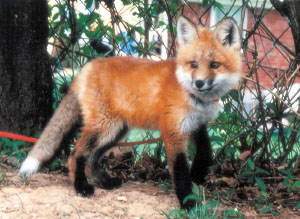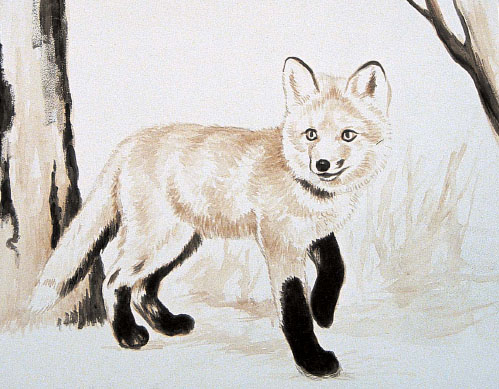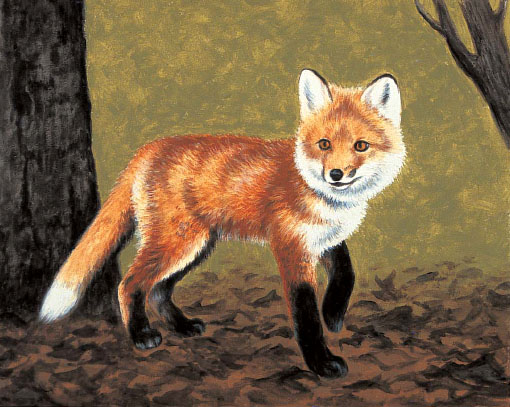Project 35: Fox Cub
This pretty little red fox cub had been orphaned and was in the care of a wildlife rehabilitator. I was impressed by the alertness and intelligence in the cub’s eyes as well as the quickness and agility present in such a young animal. I imagined how the fox would look after he had been released into the woods.


Reference Photo
Materials
Paints
Burnt Sienna
Burnt Umber
Cadmium Orange
Hansa Yellow Light
Hooker’s Green Permanent
Naples Yellow
Raw Sienna
Titanium White
Ultramarine Blue
Brushes
no. 3 and 10 rounds
no. 8 and 10 brights

1 Establish the Form
Lightly draw the fox cub onto the panel with a pencil, using a kneaded eraser to make corrections or lighten lines. Use diluted Burnt Umber and a no. 10 round to establish the main lines and the form.
Tip
If you find it hard to see where the middle value colors are in your reference photo, squint your eyes. This will eliminate detail and cause the values to stand out.

2 Paint the Dark Values
Mix a black for the cub’s darkest parts—legs, nose, mouth and the outline around the eyes and ears—with Burnt Umber and Ultramarine Blue. Paint with a no. 10 round, switching to a no. 3 round for the face and ears.

3 Paint the Middle Values
Mix a rufous color with Burnt Sienna, Cadmium Orange and Titanium White. Paint the fur with a no. 10 round, using strokes that follow the hair pattern.
Mix a blue shadow color with Titanium White, Ultramarine Blue and Burnt Umber. Paint the shadows in the ears, under the neck and chest ruff, and on the legs with a no. 10 round.
Mix a warm gray for the tree trunk with Titanium White, Burnt Umber and Ultramarine Blue. Paint vertical strokes with a no. 10 round.

4 Paint the Light Values and Background
Mix an earth green color with Naples Yellow and Ultramarine Blue. Paint the background with a no. 10 bright. Switch to a no. 10 round for around the cub’s outline. Use dabbing, semicircular strokes.
Mix a brown leaf color for the ground with Titanium White, Raw Sienna and Burnt Umber. Paint with a no. 10 bright, using dabbing, horizontal strokes. Switch to a no. 10 round for around the cub’s legs and feet. Blend into the green background using the dry-brush technique.
Mix a blond highlight color with Titanium White and small amounts of Hansa Yellow Light and Cadmium Orange. With a no. 10 round, use tuft-shaped strokes following the fur pattern.
Mix a warm white for the ears, ruff, chest and tip of the tail with Titanium White and a touch of Hansa Yellow Light. Paint with a no. 10 round.
Mix a warm brown eye color with Cadmium Orange, Raw Sienna and Titanium White. Paint the eye with a no. 3 round. Use some of the blue shadow color for the corner of the left eye.

5 Add Detail
Paint a thin glaze over the blond areas of the coat with rufous and water, using a no. 10 round. Add detail to the coat with a no. 10 round and rufous. Add dark detail with black, blending with rufous.
Use the dry-brush technique to paint texture on the tree trunk using black and a no. 8 bright. Use black and a no. 10 round for fallen leaf detail on the ground.
Blend into the earth green background color with smaller, lighter value detail.

6 Add More Detail to the Cub and Background
Continue to add detail to the fur with no. 3 rounds, blending with the adjacent color or with a clean, damp brush. Add blue shadow color detail to the white areas of the fur, blending with warm white. For lighter value detail, add some Titanium White to the blue shadow color.
Mix a leaf highlight color with warm white and some of the brown leaf color. Paint highlights with a no. 10 round.
Mix dark green with Hooker’s Green Permanent, Cadmium Orange, Burnt Umber and Ultramarine Blue. Use a no. 10 round on the small woodland plants. Mix a green highlight color with a portion of earth green and Titanium White and Hansa Yellow Light. Paint highlights with a no. 10 round. Paint some tree leaves in the background with dark green thinned with a small amount of water. Paint some of the leaves with less paint to create a sense of distance. With diluted black, paint a few saplings in the background.

THE YOUNG FOX
Acrylic on Gessobord
8” × 10” (20cm × 25cm)
7 Paint the Finishing Details
With a no. 3 round and the blond highlight color, continue to add detail to the fur. Soften the outline of the ears with a small amount of earth green and a no. 3 round. Paint some dark detail in the tail with black and a no. 3 round. Add lighter detail with the blond highlight color, then blend and soften with warm white. Add some very light strokes of rufous to the blue shadowed areas of the ruff, chest and tail.
Use a no. 10 round to restore color and integrate the reddish parts of the coat with a thin glaze of rufous and water. Re-establish highlights as needed.
Using black, the eye color and separate no. 3 rounds, blend where the dark pupils and the outline of the eye meet the warm brown eye color. Mix a highlight color for the eye with Titanium White and the blue shadow. Use a no. 3 round. Paint the corner of the left eye with blue shadow color.
Soften the outline of the nose with the blue shadow color and a no. 3 round. Paint the whiskers with diluted black and a no. 3 round, using light, feathery strokes. Tone down as needed with warm white.
To help integrate the fox with the background, add some touches of rufous with a no. 10 round using small, dabbing strokes on randomly selected lighter value leaves.
